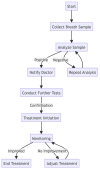Unveiling Colorectal Cancer Biomarkers: Harnessing Biosensor Technology for Volatile Organic Compound Detection
- PMID: 39066110
- PMCID: PMC11281049
- DOI: 10.3390/s24144712
Unveiling Colorectal Cancer Biomarkers: Harnessing Biosensor Technology for Volatile Organic Compound Detection
Abstract
Conventional screening options for colorectal cancer (CRC) detection are mainly direct visualization and invasive methods including colonoscopy and flexible sigmoidoscopy, which must be performed in a clinical setting and may be linked to adverse effects for some patients. Non-invasive CRC diagnostic tests such as computed tomography colonography and stool tests are either too costly or less reliable than invasive ones. On the other hand, volatile organic compounds (VOCs) are potentially ideal non-invasive biomarkers for CRC detection and monitoring. The present review is a comprehensive presentation of the current state-of-the-art VOC-based CRC diagnostics, with a specific focus on recent advancements in biosensor design and application. Among them, breath-based chromatography pattern analysis and sampling techniques are overviewed, along with nanoparticle-based optical and electrochemical biosensor approaches. Limitations of the currently available technologies are also discussed with an outlook for improvement in combination with big data analytics and advanced instrumentation, as well as expanding the scope and specificity of CRC-related volatile biomarkers.
Keywords: VOC; biomarkers; biosensor; colorectal cancer; early diagnosis; non-invasive; volatile organic compounds.
Conflict of interest statement
The authors declare no conflicts of interest.
Figures




Similar articles
-
Volatile organic compounds in breath can serve as a non-invasive diagnostic biomarker for the detection of advanced adenomas and colorectal cancer.Aliment Pharmacol Ther. 2020 Feb;51(3):334-346. doi: 10.1111/apt.15622. Epub 2019 Dec 20. Aliment Pharmacol Ther. 2020. PMID: 31858615 Free PMC article.
-
Volatile organic compounds as new biomarkers for colorectal cancer: a review.Colorectal Dis. 2016 Jul;18(7):654-63. doi: 10.1111/codi.13271. Colorectal Dis. 2016. PMID: 26752703 Review.
-
Potential role of volatile organic compound breath testing in the Australasian colorectal cancer pathway.ANZ J Surg. 2023 May;93(5):1159-1161. doi: 10.1111/ans.18195. Epub 2023 Jan 11. ANZ J Surg. 2023. PMID: 36629356 Review.
-
Fecal volatile organic compounds for early detection of colorectal cancer: where are we now?J Cancer Res Clin Oncol. 2019 Jan;145(1):223-234. doi: 10.1007/s00432-018-2821-3. Epub 2018 Dec 15. J Cancer Res Clin Oncol. 2019. PMID: 30554400
-
Electronic nose can discriminate colorectal carcinoma and advanced adenomas by fecal volatile biomarker analysis: proof of principle study.Int J Cancer. 2014 Mar 1;134(5):1132-8. doi: 10.1002/ijc.28446. Epub 2013 Sep 2. Int J Cancer. 2014. PMID: 23959518
References
-
- World Health Organization Colorectal Cancer. [(accessed on 11 July 2023)];2023 Available online: https://www.who.int/news-room/fact-sheets/detail/colorectal-cancer.
-
- Moen L., Liu B., Bukirwa P., Chingonzoh T., Chokunonga E., Finesse A., Korir A., Lamin B., Lorenzoni C.F., Manraj S.S., et al. Trends in the incidence of colorectal cancer in sub-Saharan Africa: A population-based registry study. Int. J. Cancer. 2024;155:675–682. doi: 10.1002/ijc.34942. - DOI - PubMed
Publication types
MeSH terms
Substances
Grants and funding
LinkOut - more resources
Full Text Sources
Medical

